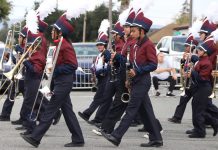
In an effort to boost the achievement of students whose first
language is Spanish, the Aromas-San Juan Unified School District on
Wednesday approved recommendations to incorporate Latino culture
into school curriculums and extend and improve bilingual
education.
In an effort to boost the achievement of students whose first language is Spanish, the Aromas-San Juan Unified School District on Wednesday approved recommendations to incorporate Latino culture into school curriculums and extend and improve bilingual education.
By approving the recommendations of the Language Task Force 4-1, the board agreed to consider the task force’s findings.
The recommendations include:
– Implementing primary language instruction from fourth through eighth grade
– Improve recruiting and retention of quality bilingual and bicultural staff in all areas
– Implement instructional interventions to support students who are at-risk
– Integrate Mexican American and Latino culture and history throughout curriculum and extra-curricular activities
– Promote non-Latino and non-Spanish speaking students in the bilingual program
The fine print to implement the changes is still on the drawing board. Formed by staff and parents, the task force has been doing research and studies since September.
Trustee Jeff Hancock was the only board trustee to vote against the recommendations.
“It’s hard for me to see this program implemented when I’ve witnessed similar programs not work in the past,” he said. “My goal in this district is when every child leaves, they’re educated. I’m more concerned with that than political correctness.”
Hancock went on to say he wasn’t attacking the work of the task force, but didn’t agree with the idea of changing the program.
Sergio Martinez’s daughter is a kindergartner at Aromas School. He responded to Hancock’s comments by saying “You say you’re not addressing the work of the task force, but I find that condescending because this is what our kids need to succeed and you’re saying we shouldn’t provide that.”
Board Trustee Rachel Ponce disagreed with Hancock and said this isn’t a political issue.
“The whole conversation of bilingual education always turns to politics and it’s not,” she said. “It’s a need that we have to address.”
One of the recommendations would integrate Mexican-American and Latino culture and history throughout the curriculum and extracurricular activities.
“I would like to see more students getting involved with the Chicano studies class,” Anzar High student Sandra Campos said. “I think a lot of people don’t really know about Chicano history and culture. I mean when someone asked me who Caesar Chavez was and I didn’t know, it was pretty embarrassing.”
Katy Stonebloom, district adviser for English learner services, believes people in the community aren’t educated about how this land was founded and the history behind the community.
“Integrating Latino culture into the U.S. history will help inform students about where they live,” she said.
Board Trustee John Ferriera said it’s important for students to know the early history of the county.
“It always amazes me when I hear kids ask who the first settlers here were and they say the Pilgrims,” he said.
The recommendations from the task force also ask the district to continue the bilingual education program past third grade and potentially through eighth grade.
It takes one to three years for students to learn conversational language, but it takes three to seven years for them to learn academic language, said Ercilia Zavala, principal at Aromas School.
Parents on the task force are concerned the students aren’t ready to be placed in a non-Spanish speaking classroom after third-grade.
Ferriera said the recommendations are going to be hard to accommodate, but it’s worth a try.
“I know there are a lot of different reasons why kids drop out of school, but I don’t want one of those reasons to be because they didn’t understand what they were learning,” he said.
The group also asked that the district try to recruit more bilingual teachers, and promote participation of non-Latino students to participate in the bi-lingual program.
Currently 34 percent of students at San Juan School are English Language Learners (ELL), and 28 percent of Aromas School students, according to Superintendent Jackie Munoz.
“I think the approval is absolutely wonderful,” she said. “The parents did a wonderful job of presenting and there was a lot of investigation and lots of studies looked at to come up with their results.”
The Language Task Force will hold its next meeting Thursday, April 22 at the Anzar High School Library. With the recommendations now passed, the task force will discuss its next steps of action at the next meeting.









